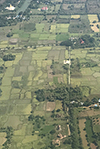|
|
|
Ava
Name of an ancient kingdom in
Myanmar, with its capital
near present-day Mandalay and founded in 1365 AD by the
Shan
King
Thadominbya (fig.), who reunified
central
Burma. It ruled
upper Burma for nearly two centuries, until the beginning of 1555, when it was
captured by the
Taungoo King
Bayinnaung (fig.),
who incorporated it into his realm, which initially was formed by assembling
formerly autonomous Irrawaddy-valley-based kingdoms, and eventually grew to
become the Taungoo Empire. In Burmese, both the Ava
Kingdom and its capital are known as
Inwa.
After the fall of the Ava Kingdom,
Ava City became the capital of all Burma and remained in this position during
the Toungoo and Konbaung periods, though it in these periods relocated several times
at intervals to and from
Pegu.
Highlights within the
city walls (map
-
fig.)
include Nanmyin
Watchtower, i.e. the Leaning Tower of Ava (map
-
fig.);
the Royal Ritual Pond (map
- fig.);
the brick
monastery
Me Nu Oak-Kyaung (fig.);
the White Temple known locally as
Yattana Pontha (fig.);
Ava's
own
Shwezigon Phaya (fig.);
and the ancient city gates in the South (map
- fig.),
West (map
-
fig.) and East (map
-
fig.);
while landmarks outside of the city walls include
Daw Gyam Phaya Su (fig.);
Yattana Shihmih
(fig.);
Inwa
Archaeological Museum (map
- fig.);
the southwestern
Sin Kyone Fortress (map
- fig.) and the
Tha Byae Tan Fortress (map
- fig.),
located to the
north of Ava near the
old Ava bridge
or
southern bridge (map
-
fig.), as well as
Asaykhan Fortress (map
-
fig.);
Le Htat Gyi Phaya (fig.);
Lawkataraphu Phaya Kyee (fig.);
Mashi Khana Wih Mahla Phaya The Kyaung Taw
(fig.),
with its
Buddha image
seated on a
naga,
while performing a
varada
mudra
with his right hand (fig.); the wooden monastery
Bagaya Kyaung (map - fig.)
with it's two
pagodas (fig.)
and a grove in the field beyond the
compound with the freestanding Tawagu Pagoda;
the Nine Queens' Pagodas (map
-
fig.)
with a
nearby freestanding white pagoda (fig.),
as well as the four ancient
south-westernmost brick monuments of
Win Ga Bar
(fig.);
Myinmo Taung (map
-
fig.); Lawka Dotha Mahn Aung
Pagoda (map
- fig.)
and Kyaung Lain Monastery
(fig.),
amongst others.
Ava is officially known as
Rattana Pura, and in Thai
it is referred to as
Ang Wa. See also
Forty Years' War.
See MAP.
回






|
|

